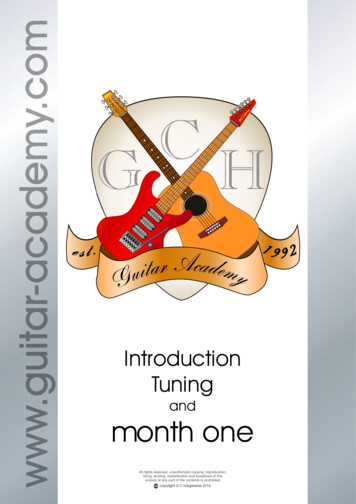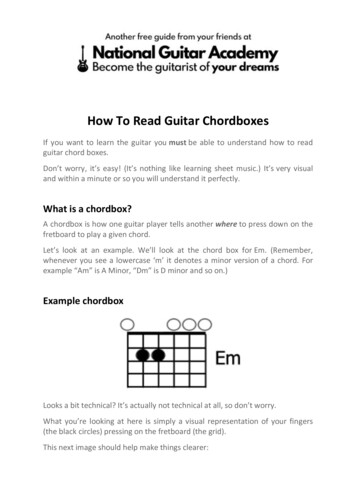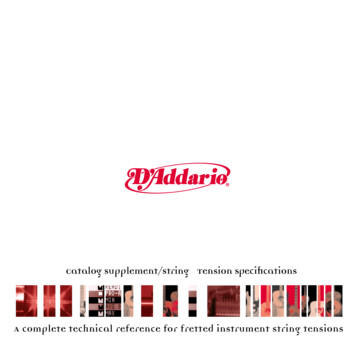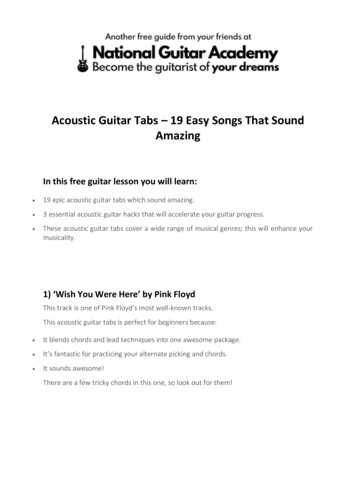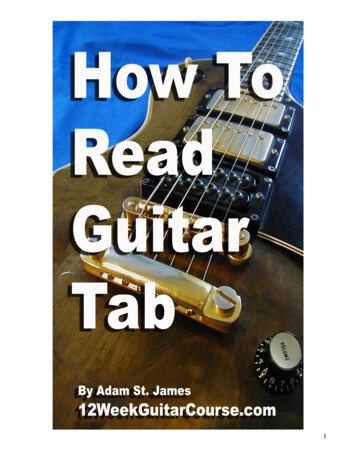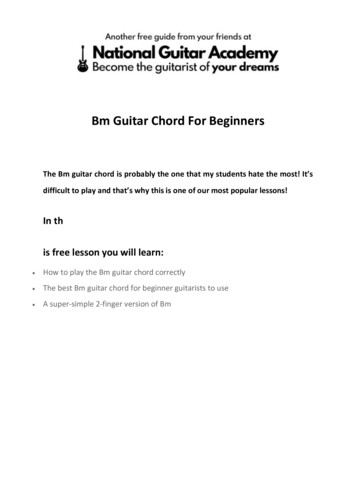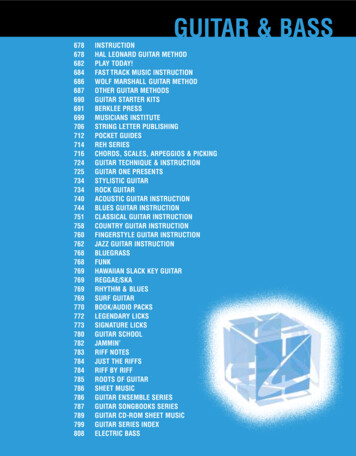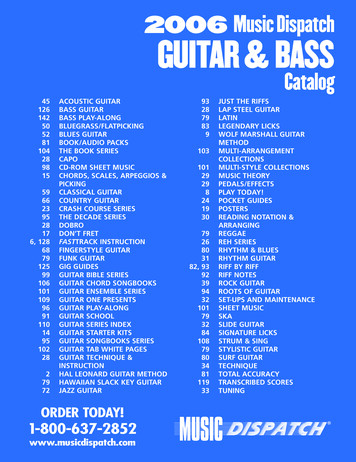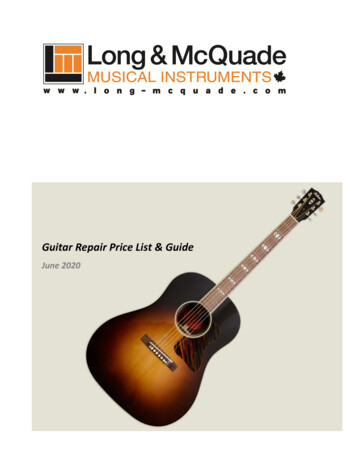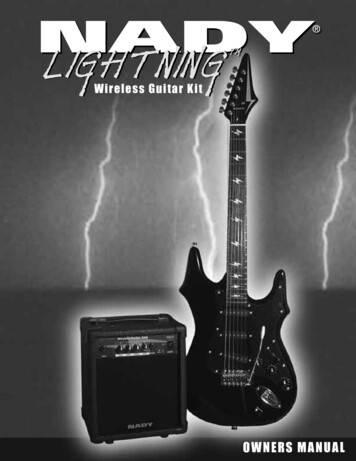
Transcription
Wireless Guitar KitOWNERS M A NU A L
Con t e n t sGuitar Kit Contents . 2Introduction . 3Features . 3Lightning Guitar Parts . 4Taking Proper Care of Your Lightning Guitar . 5Learning How to Play Your Lightning Guitar . 5Lightning Wireless Guitar Operation . 6Installing the Vibrato Arm, aka “Whammy Bar”. 6WGA-15 Wireless Guitar Amp Operation . 7Specifications . 7Service . Back CoverGuit a r K i t C o n t e n t sWireless Electric GuitarPadded Gig BagWGA-15 WirelessGuitar AmpAdjustment WrenchesInstrument CableAdjustable BlackNylon StrapVibrato Arm, aka“Whammy Bar”(2)3 Guitar Picks
Int r o du c t i o nThank you for choosing the Nady Lightning Guitar and Amp, the world’s first totally wireless starter guitar kit, and congratulations on your choice. This manual will show you how to set up your kit and play with the freedom and convenienceof wireless operation while you learn to play the guitar. Playing wireless will make this experience even more fun. TheLightning Guitar and WGA-15 Amplifier can also be used by any level of player as both offer top professional features andperformance so you will never outgrow this kit, which can serve for years as a perfect practice setup no matter what skilllevels you achieve.The following pages explain the operation of your system’s components to enable easy set-up. Please read this manualcarefully to get the most out of your Nady Lightning Guitar starter kit.Date of Purchase Dealer’s NameCity State ZipModel #Model #Serial #Serial #Fea t u r e sLightning Guitar bolt inlays, easy-access adjustable truss rod, 3 pickups with 5-way selector switch, volume and dual tone controls andvibrato Built-in VHF wireless transmitter with internal antenna allows wireless operation up to 200’ line-of-sight without cordswhen used with WGA-15 wireless guitar amp or any Nady VHF Wireless receiver on the same channel Easy to operate. Just turn on Lightning guitar transmitter (TX ON LED) and WGA-15 amp and you’re ready to play cordless. (Can also be used with a conventional cord connection to amp.) Operates on 2 X 9V alkaline batteries (up to 50 hours battery life) in convenient rear battery compartment with uniquemagnetic latched door (no tools needed to access).WGA-15 — 15W Wireless Guitar Amplifier Versatile, powerful practice amp with 15W RMS output; 6” speaker; Gain, Volume with killer distortion; Treble and Basscontrols; Headphone output Built-in VHF receiver with Receiver On and Audio Received LED’s(3)
Ligh t n i n g G u i t a r P a r t sT these terms for a better understanding of your instrument.TUNING PEGS &MACHINE HEADSHEADSTOCKSTRINGTREENUTFRETSNECK &FRETBOARDLIGHTNING BOLTFRET MARKERSSTRAP BUTTONPICKGUARD5-WAY PICKUPSELECTORSWITCHNECK PICKUP#1 #2 3# #4 #5MIDDLE PICKUPBODY#1 NECK PICKUP ONLY#2 NECK & MIDDLE PICKUPS (HUM CANCELING)#3 MIDDLE PICKUP ONLY#4 MIDDLE & BRIDGE PICKUP (HUM CANCELING)#5 BRIDGE PICKUP ONLYBRIDGE PICKUPVOLUME CONTROLTONE (NECK PICKUP)BRIDGETONE (MIDDLE PICKUP)VIBRATO ARM,aka "WHAMMY BAR"PLUG-IN OUTPUTSTRAP BUTTONBATTERY COMPARTMENT W/ MAGNETIC LATCHDOOR FOR (2X) 9V ALKALINE BATTERIES(BACK OF BODY)TRANSMITTER ON/OFFSWITCH W/ LED INDICATOR(4)
Ta k i n g P r o p e r C a r e o f Yo u r L i ghtning GuitarIt is best to establish early a habit of taking proper care of your Lightning Guitar. As it will take discipline to learn to playthe instrument quickly and as well as your talents can take you, a good place to start is in taking good care of your guitar.This will not only prolong its life and ensure best performance, but also will foster a respect which will serve you best inachieving your goals. The following is a good guide to always keep in mind and practice as you learn to play.a. Cleaning and Maintenance:Use a soft, dry cloth to clean the strings of your guitar each time after you play. This prevents hand moisture fromrusting your strings and shortening their life.Polish your guitar every few months using instrument polish available at music stores. These contain smallamounts of non-silicon wax and maybe a little lemon oil.To prevent the fingerboard from developing dry crack marks over time wipe them occasionally with a cloth dippedin lemon oil.Two adjustment wrenches are included with the Lightning Guitar. The Truss Rod Wrench is the large wrench andcan be used for the properly adjusting the action of the neck. The neck adjustment is located above the nut. Thesmaller wrench is the Bridge Wrench and is used for adjusting the bridge for both action and intonation. Do notattempt these adjustments on your own. These should only be done by a qualified guitar repairman.b. Handling Care:Never lean your guitar against objects or the wall as it can then easily be knocked over and damaged. Also, neverleave it lying on the floor or on your bed as it can be severely damaged if inadvertently stepped or sat on. Use guitar stands, such as the Nady GS-1, for proper secure short-term placement every time. If not using for a long timeit’s best to keep the guitar stored in your supplied carrying case.Since your strings are under tension, they are sensitive to extreme changes in temperature, which will severelyeffect your tuning and may even harm the instrument. Never leave your instrument in the trunk of a car when theweather is very hot or extremely cold. If you must store your guitar inside a car, it is best to release the tensionfrom the strings by detuning the guitar and then afterwards allow the instrument temperature to stabilize beforeretuning to proper pitch.c. Changing Strings:It is good practice to replace the strings periodically, as they will lose their brilliance and tone after a while. Howoften you need to do this is dependant on the type of strings and their diameter. Generally the thinner strings willneed to be replaced most often and they are also the most likely to break while you are playing if they’ve not beenchanged for some time. Generally it is best that when the strings start sounding dull, replace them.L earning How to Play Your L i gh t n i n g G u i t a rAs with learning any new skill, it is best to develop good technique and understanding of your instrument right from thestart as that will make the journey to proficiency faster and more enjoyable. Learning on your own with little guidance canbe a daunting task and slow your progress considerably. There is simply no reason to “rediscover the wheel” when thereare so many guitar instruction books, in virtually any style which interests you, so readily available. These will help youquickly develop a good foundation from which you can then more easily “discover your own voice” on the guitar. Depending on your interest and preferred musical styles, a visit to your music store or a search on the internet before you evenstart trying to play anything on your guitar will help you find the best learning aids to speed you on your musical journey.We have not included any rudimentary guitar instruction with this kit as such are necessarily usually too sketchy and notas effective as one of the many well respected guitar teaching aids readily available which would serve you, the beginningstudent, better in the long run. For even better results faster, find a good teacher or guitar instruction program as there isno substitute for expert guidance right from the start when learning new skills.Learning to quickly and accurately tune your guitar is a skill you must master first. Since there are many alternate tunings used in popular music, depending on the style you choose to play, we recommend a good chromatic tuner, which willgive you more choices for training your ear to accurately tune your instrument for alternate popular tunings than just thestandard E-A-D-G-B-E, which is most common. Check with your local music store or on-line guitar accessories providerfor a good quality tuner, preferably a chromatic electronic model, although standard tuning pitch pipes can also be a usefulstart.(5)
L i g htning Wireless Guitar O p e r a t i o nYour Lightning Guitar can be operated either as a conventional guitar with the supplied cord or completely wireless, utilizing its built-in transmitter and the wireless receiver built into the WGA-15 Guitar Amplifier. Cord operation is possible withthe WGA-15 or any guitar amp and is sometimes convenient and preferred.Before playing your guitar, either wired or wireless, you should familiarize yourself with its controls and understand theiroperation.The Volume Control (1) adjusts the overall audio level ofyour guitar, as produced by the pickup(s) selected. The audiooutput is routed to both the Plug-In Output Jack (5) for cordoperation and to the internal Transmitter for wireless operation.There are 2 tone controls for shaping the frequency responseof the audio produced by the pickup selected. The upper ToneControl (2) effects only the Neck Pickup (8) when that isselected by itself or in combination with the Middle Pickup (9).Similarly, the lower Tone Control (3) effects only the MiddlePickup (9) when that is selected by itself or in combinationwith the Neck Pickup (8). There is no tone control for theBridge Pickup (10), which is usually selected for its brightoutput, rich in treble harmonics, when that type of sound isdesired. Use the 5-way Pickup Selector Switch (4) to selectpickups as noted in the illustration on page 4 for the desiredsound. Note that generally the bassiest tones are achievedwith the Neck Pickup (8) and that the Middle Pickup (9)produces more treble and mid range tones, but not as manyhigher tones as the Bridge Pickup (10). Also note that Positions #2 and #4 offer pickup combinations that result in theleast hum pickup, as can be caused by nearby AC wiring andlighting. Depending on whether you are playing lead or doingrhythm chording, or a combination, you will find these controlsto be very versatile in offering a wide range of sounds.(8)(4)(9)(10)(1)(2)(3)(5)(7)(On Back)(6)On the back panel of the guitar is the Battery Compartment (7). It can be opened by pulling up the plastic cover at thefinger notch. Two fresh 9V alkaline batteries should be inserted observing the correct polarity. Close the compartment. Itwill magnetically snap shut.Turn on the transmitter by pressing the Transmitter OFF/ON Switch (6). The LED internal to the switch will turn on redindicating the transmitter is on. The Plug-In Output Jack (5) overrides the transmitter so that the transmitter audio will bebypassed if a cord is plugged in. When the cord is removed the audio will be transmitted. Turn off the transmitter whenusing a guitar cord to preserve your battery strength.The LED indicator will become dim or turn off to indicate the battery is weak or dead, at which point, the batteries shouldbe replaced with fresh ones.Plug in and turn on the WGA-15 Wireless Guitar Amp. The TX LED (13) on the WGA-15 amp should now be lit. The guitar is now ready to play.(Note: Turning down the guitar volume too much can compromise the signal-to-noise ratio and is not recommended. Setthe guitar volume for higher gain to reduce noise if encountered).I n stallling the Vibrato Arm , a k a “ W h a m m y B a r ”Carefully insert the threaded end of the vibrato arm/ whammy bar into the socket in the bridge. Rotate the arm clockwiseuntil it is firmly attached. If you prefer a loose arm which swings do not turn all the way. Turn in tighter if you wish arm tohold preferred position, but do not overtighten. While playing, depress the arm to lower pitch and pull up on it to raise thepitch. You will find this a very useful feature that will allow more expression in your playing.(6)
W GA-15 Wireless Guitar Am p O p e r a t i o n(21)Back of WGA-15(15)(16)(17)(18)(19)(20)(14) (13)(12) (11)Front Panel(11) POWER SWITCH — Turns on power to the amplifier. Make sure unit is plugged into AC and the Level control isturned down before turning on the amp.(12) POWER LED — Lights red to indicate the power is on.(13) TX LED — Lights green to indicate the guitar transmitter is on, within range, and the RF signal is being being received.(14) AUDIO LED — Lights amber to indicate audio is present.(15) PHONE JACK — This jack should be used for headphones. When plugging into this jack, the internal speaker isdisabled.Note: This jack is meant to receive a stereo headphone 1 4” TRS plug. Do not plug a mono 1 4” TS plug into this jack(16) INPUT JACK — Use this jack to plug in the guitar cord when not in wireless operation. Plugging into this jack willautomatically disable the wireless receiver capability.(17) GAIN CONTROL — This control adjusts the input gain of the guitar audio. Turn this control to minimum for cleansounding guitar. Turn it to maximum for heavy distortion. Blues style distortion can be achieved by setting this control tomid.(18) LEVEL CONTROL — This control adjusts the final master volume of the audio.(19) TREBLE CONTROL — This control adjusts the treble frequencies (approx 5K Hz) to increase high cut, presence,and add definition to your sound.(20) BASS CONTROL — This control adjusts the bass frequencies (approx 120 Hz) for warmer sound and stronger lowend.(21) ANTENNA — The antenna wire is dressed inside the amp cabinet. Do not remove or reposition this wire.S pecificationsReceiver not operational if cord is plugged into amp INPUT jackTransmitter and Receiver Antennas: Both internal to guitar andamp respectivelyBuilt-In Wireless SystemRF Transmission Frequency: 171.90MHz (Ch A)Frequency Response: 40-20,000 Hz, /-3dBDynamic Range: 100dBTotal Harmonic Distortion: 0.65%Operating Range: up to 200 ft. line-of-sightTransmitter Batteries: Two 9V alkaline, 26mA drain, up to 30hours battery lifeControls and Indicators:Lightning Guitar (transmitter): Transmitter ON/OFF rockerswitch with integrated LED “ON” indicator (LED dims below6.9V indicating need for battery change). Transmitter not operational if cord is plugged into guitar OUTPUT jackWGA-15 (receiver): Amp power/Receiver ON/OFF rockerswitch LED indicators: Power ON, TX ON (transmitter signalreceived), and AUDIO ON (audio signal from guitar received)(7)WGA-15 Guitar AmpPower Output: 15 Watts RMS @ 4ΩSpeaker: 5” full-range guitar speakerImpedance: 4ΩPower handling: 20 WattsGuitar Input Connector: 1/4” TS mono connectorInput Impedance: 200KΩHeadphone Output Connector: 1/4” TRS stereo connectorBass Control: /- 12dB @ 120HzTreble Control: /- 12dB @ 5KHzPower Requirements: 115VAC 60HzInternal Fuse: 0.5A 250VDimensions HWL: 11.8” x 5.7” x 7.4”Weight: 10.5 lbs
SERVICE FOR YOUR NADY AUDIO PRODUCT(U.S.) Should your NADY LIGHTNING WIRLESS GUITAR product require service, please contact the Nady ServiceDepartment via telephone at (510) 652-2411, or e-mail at service@nady.com.(International) For service, please contact the NADY AUDIO distributor in your country through the dealer fromwhom you purchased this product.DO NOT ATTEMPT TO SERVICE THIS UNITYOURSELF AS IT CAN BE DANGEROUS ANDWILL ALSO VOID THE WARRANTY.NADY SYSTEMS, INC. 6701 SHELLMOUND STREET, EMERYVILLE, CA 94608Tel: 510.652.2411 Fax: 510.652.5075 www.nady.com
achieving your goals. The following is a good guide to always keep in mind and practice as you learn to play. a. Cleaning and Maintenance: Use a soft, dry cloth to clean the strings of your guitar each time after you play. This prevents hand moisture from rusting your strings and shortening their life.
